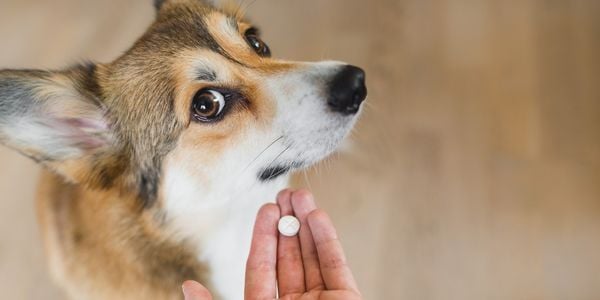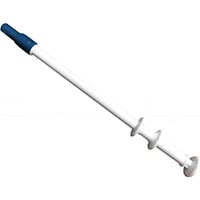Whether it's a monthly parasite preventative, supplement, or prescription medication, your dog may turn their nose up or run for cover when you try to give them a pill.
While some dogs inhale just about anything you offer them, many dogs seem to have a sixth sense when it comes to knowing if there's medication hidden in their food.
Your dog may eat all the food in their bowl while carefully avoiding the pill or eat the treat but spit out the pill itself.
It can be tricky – and even dangerous – to try and force your dog to take a pill or other medication. And every time they have a bad experience, the harder future pill-giving becomes.
Many people ask veterinarians how to give their dog pills and what's the best way. In my opinion, it's best to mask it, but there are a few options you can try if your dog won't take their pills.
Being sure our dogs get their medication is critical. But we don’t want it to be a bad experience for them (or us!).
Table of Contents:
Benefits of Using Pill Wraps for Disguising Dog Medication
You may be wondering, especially when you are in a hurry, why you should bother wrapping your dog’s pills when you can just toss them in their food or down their throat. In my opinion, there are a few reasons why it may be a good idea.
- Prevents Pill Avoidance. Wrapping your dog's medications helps your dog avoid being exposed to any bitter taste from the pill that may cause them to gag and drool.
Dogs remember and learn from their experiences, so this may make giving pills the next time much harder. Even if a medication says it's "flavored," it doesn't mean it will be liked by every dog. - Keeps Your Relationship Strong. You don’t want your dog to think you are the "evil pill monster" by chasing or wrestling with them. Another thing they'll remember! You want to be someone your dog trusts, not someone they run away from or avoid.
- Guarantees Your Dog Has Ingested Their Medication. By hand-delivering a wrapped pill, it helps better guarantee your dog eats it, especially those that are magicians at hiding it in their mouth.
You know, the ones that hide it so well only for you to find it hours or days later in their bed or on the floor.
Daisy was a genius at "saving her pills for later" by hiding them in her beard (photo below).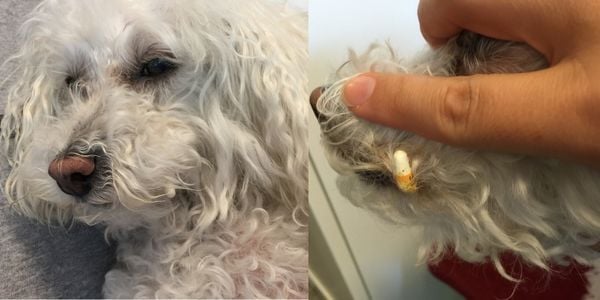
If you give medication in your dog's regular food, they may just eat around the pill, or they may develop an aversion to their regular diet and stop eating. - Prevents Dog Bites or Choking. Giving a masked pill makes the process of medicating safer for you and your dog. If they take it willingly wrapped up, they are less likely to choke or have it put down their trachea.
It helps prevent you from accidentally getting bit. See this pill-giving game that makes medication time more fun. - Give Multiple Pills at Once. Wrapping pills saves you time if there are multiple small pills – one and done!
- Prevents Medication Waste. Masking pills saves you money since you are less likely to waste or lose pills from repeated attempts.
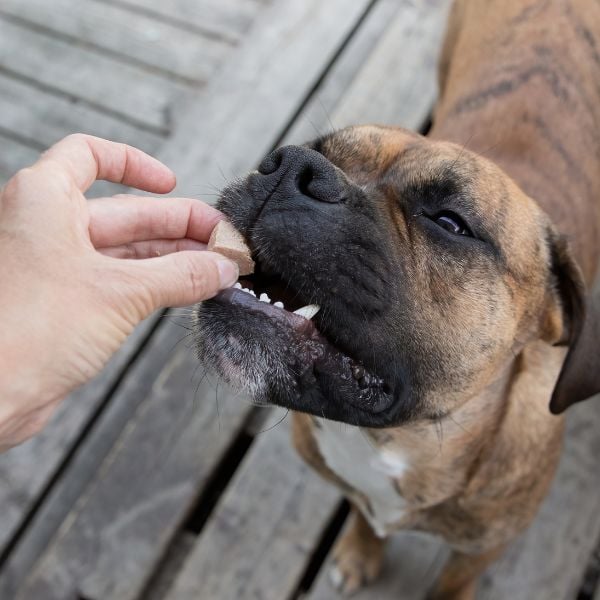
Pill Wrapping Ideas for Dogs
When wrapping a pill, you want the wrap to stay in place, be a flavor or food your dog willingly takes, and you want it to have a stronger smell than the pill.
It is important when selecting a ‘wrap’ to be sure:
- It does not contain anything toxic, such as xylitol, onions, or garlic
- Your dog does not have an intolerance or allergy to it
- It isn’t too high in fat, especially for dogs with a history of pancreatitis
- It isn’t too high in sodium, especially for dogs with heart or kidney issues
Hypoallergenic Pill Wraps for Dogs
For dogs on restricted protein diets, you want to make sure the wrap doesn't have anything that will cause a reaction. Even ingredients like gelatin are a no-no for dogs who can't eat beef.
Marshmallows
Cut a slit in the middle, and you have a pill pocket. You can potentially only use half of a large marshmallow, depending on the size of the pill, or squish together a couple of tiny marshmallows around the pill.
Note: The use of marshmallows should be for short-term pill giving. Because marshmallows have sugar and they're very tacky, they're not the best for your dog's teeth or waistline if used for many months or years.
Happy Belly Marshmallows do not have coloring but are made of corn, so avoid them if your dog is allergic to corn.
These Sweet Apricity vanilla marshmallows are paleo-friendly, in case you wanted to have a snack yourself while pilling your dog.
If your dog has an allergy to the protein in their food, then these vegan marshmallows will not impact their allergies unless they have an allergy to soy, as Sarah's Candy Factory marshmallows have soy.
Dairy-free cream cheese
Dairy and soy-free cream cheese spreads are an option. You can also use hard cashew or almond cheese, but it's even more expensive than almond cheese spreads.
Note: Nuts can cause gastrointestinal upset. Cashews, almonds, and coconut are high in fat, so use caution in pets with sensitive intestinal tracts, those suffering from pancreatitis, hyperlipidemia, or obesity.
Dates
Use pitted dates and cut them in half — you will have two nice pill pockets. If your dog is small, you may need to cut up large dates even more.Dog-safe fruit
Cut fruit pieces big enough so you can make a slit in them and slide the pill in. You can use peaches, seedless watermelon, cantaloupe, honeydew melon, banana, etc. For more choices, check out our safe fruit list for dogs.Glutinous or sticky rice
Sticky rice can be made into a ball around the pill, and it is gentle on the stomach.
Potatoes
Plain mashed potatoes: You can mold a ball around the pill. Do not use any dairy or seasoning when making them. Dehydrated potato flakes have a very long shelf life, and by just adding water, you can make a little bit at a time.Plain baked potato wedges: Make a small cut and slide the pill in. Do not use any seasoning.
Boiled sweet potato cubes: You can also steam sweet potato cubes. Make sure they're cool before using them.Hypoallergenic pill pockets
Check the ingredients carefully each time to be sure nothing has changed in the ingredients list.The Presidio pill pockets don't have any animal protein, so they're perfect for dogs with food sensitivities to meat.
The Pinchers pill pocket treats have soy, but they have the added benefit of probiotics.
Unsweetened coconut yogurt
Using yogurt works if you have to crush the pill, or you can open a capsule into it. Be sure to mix well prior to giving.
Cocojune is a great brand that our team has tried and loves. It has a strong taste, which can be good to block most pills, especially a capsule opened into it.
Plain applesauce
Applesauce works if you have to crush the pill, or you can open a capsule into it. Be sure to mix well prior to giving.
Sunbutter
Sunflower seed butter is a nut-free butter option, but be sure to check the ingredients list of your preferred brand so that it doesn't contain xylitol, which is toxic to dogs.
You can make a ball with the butter around the pill or mix in a crushed pill or opened capsule.
Canned prescription food
The kibble diet your veterinarian has recommended for your dog, if they have food allergies, may come in a wet canned variety as well. So, ask your vet for their recommendation.
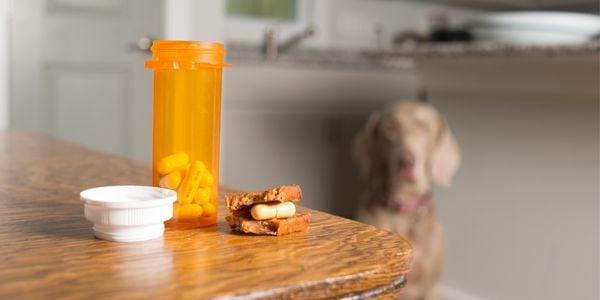
Bland Pill Wraps for Dogs
These pill wrap options are best for dogs with sensitive gastrointestinal (GI) tracts, irritable bowel syndrome, pancreatitis, or other GI conditions.
- Glutinous or sticky rice – this type of rice is gentle on the stomach
- Plain mashed or boiled potatoes – dehydrated potato flakes are easy to make by just adding water
- Bread
- Chicken – use onion and garlic-free lunchmeat, cubes of plain boiled chicken breast, or canned chicken in water (no seasoning)
- Chicken baby food – make sure the ingredient list doesn't contain garlic or onions. This one is pet-safe but still check the ingredients as recipes change.
General Use Dog Pill Wraps
You can use any of the suggestions listed above, like fruit or sticky rice, but here are some additional options if your dog doesn't have any food allergies or gastrointestinal issues.
Peanut butter – you can use regular peanut butter. Check the ingredients to be sure it doesn’t contain xylitol. PB is not the best choice for dogs who suffer or have suffered from pancreatitis.
Cheese – Use soft moldable cheese such as Kraft singles, mozzarella balls, string cheese, or Velveeta. For those that may be lactose intolerant, you can try goat’s milk cheese.
Cream cheese – This is moldable and slides down easily.
Easy cheese (in a can) – with this cracker and cheese combo, you can place the pill on a cracker and squeeze cheese on it.
Unsweetened Greek yogurt
Deli meat – Be sure to check that it doesn’t contain onions or garlic.
Liverwurst – Be sure to check the brand you select doesn’t contain onions or garlic. The Bark Pouch Beef & Liverwurst flavor of this dog treat is thick enough to wrap around pills, and it makes for a great training treat.
Chicken liver – The strong smell blocks any scent of the pill.
Chicken hearts or gizzards – They have a natural "pocket."
Plain scrambled eggs
Hardboiled egg
Pill pockets – Greenies come in many flavors, but this chicken flavor is a favorite of ours
Pill paste – this vet-formulated paste is moldable to hide any shape or size of pill
Canned cat food
Gelatin capsule – see the tips and story below
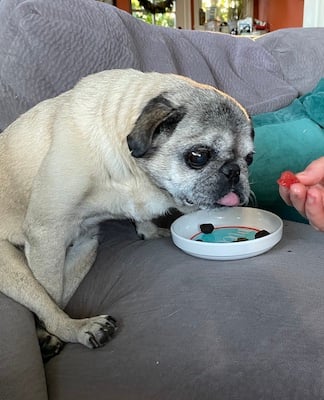
PRO TIP for bitter or smelly pills: Use a gelatin capsule. If the pill is small enough, put it right into the capsule. If not, break it up into smaller pieces or crush the pill into a powder. Next, place the pill(s) or powder into the capsule and wrap it in something smelly!
Gel Capsule True Story
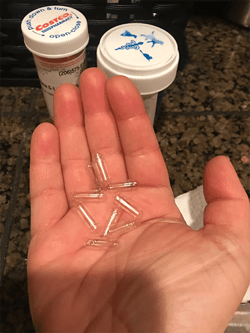
Mabel the Pug loves treats, but she can smell a hidden pill from ten miles away. In the words of Hall and Oates, she "... won't go for that."
Preventive Vet team member Mia tried every type of pill pocket, peanut butter, wet food, cheese — nothing worked ... until she tried hiding her pills in a gel capsule cover.
These gelatin capsules are a real winner in Mia's household and can be found online, or you might be able to find them at your local wellness shop.
PRO TIP from Mia: "Sometimes we have to wash our hands before we give her the pill pocket. Otherwise she can still smell the residue from the tablet, and we're back to Hall and Oates."
Gelatin capsules come in different sizes. Mia uses a smaller size 3 for her pug, but a size 1 should be good for larger dogs.
A Hard-to-Pill Success Story:
While the gel capsules do a lot of the heavy lifting, without fail, after two days Mabel would refuse to eat anything the pills were wrapped in.
Finally, her family tried baby food. This little pug went from running away from her treat dish, to happily running to be put in her bib for baby food pill time. When you watch the video below, you can actually see the joy on her face.
Her favorite flavors are carrot, butternut squash, and sweet potato. Along with the baby food, her moms are now happily buying cute adjustable toddler-sized baby bibs for her and doing photo sessions every night.
And since she's less of a delicate eater and more of a chomper, they bought her a set of soft baby spoons.
Important Reminder About Pill Wraps
I must remind you these dog pill wraps are not meant as regular treats to use outside of medicating our dog. They are just ways to make medicating a better experience for your dog and you.
Many of these wraps are high in calories, and therefore you need to be mindful of your dog’s weight to be sure they are not gaining weight, especially if they are on medications for a few weeks or more.
If you have to medicate twice daily or for an extended period of time, be sure to make adjustments in their total daily caloric intake (cut back on other treats or meal portions) and increase their activity.
Your veterinarian can help you figure out how many calories are in your wraps and how much to cut back on food. You can use our treat calculator to help as a guide as well.
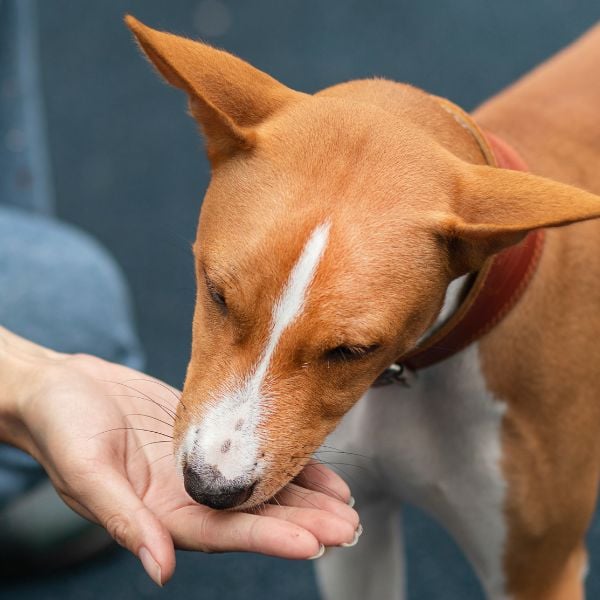
How to Wrap a Pill Successfully
Have you ever swallowed a pill wrong and suffered from the bitter aftertaste? I don’t know about you, but just thinking about it makes me want to gag. That is an occurrence we want to avoid for our dogs.
- Try various types of wraps to find the most agreeable one for your dog, and start by not putting any pills in it for a while. Let your dog just enjoy the treat wraps.
- Wrap a piece of your dog's regular food or treat in the pill wrap and give it to your dog. This can help them get used to the texture of a hard "center."
- Make sure you don't touch the pill and then touch the masking wrap. The bitter taste and smell of the pill will then be all over the masked treat, and your dog won't be fooled.
Special note: This happened to one of our colleagues; she was giving carprofen to her dog and touched the pill. She subsequently rubbed her eye.
She's allergic to ibuprofen and didn't realize they're from the same propionic drug class. Her eye swelled up, and for a while, she couldn't figure out why.
Allergy or not, it's always recommended to wash your hands after handling medication. And, if you have drug allergies or sensitivities, it is best to wear gloves when handling your pet's meds.
Pill-Giving Game for Dogs
In this short video, Preventive Vet's certified dog trainer shows how she gives her dog pain medication by using decoy treats and feeding quickly.
This technique can help dogs who don't want to take their medication or have learned that some high-value treats (like cheese or peanut butter) hide bad-tasting pills.
Decoy Pill Treat Tips:
As demonstrated in the video above, follow these tips to improve the effectiveness of this pill-giving technique.
- Do this with multiple decoy treats/pill pockets on their own without medication or with kibble wrapped inside at other times of the day.
- Provide lots of praise and excitement as you quickly feed your dog each treat one after another at a high speed.
- Feed fast! As your dog takes one treat, immediately present another treat to their mouth. You want them to swallow quickly and take the next treat without even thinking about it.
- The medicated treat or pill pocket should be in the middle of the treat order, preceded and followed by decoy treats.
When Disguising the Pill Won't Work
When the wrap just isn’t cutting it!
We all know our dogs are smart and have an amazing sense of smell. This combination can lead to pill administration failure regardless of how well you have mastered the technique of pill wrapping.
When Plan A doesn’t work, you need a Plan B. Plan B is transforming the pill or capsule into a powder form and then hiding it.
If the medication is in capsule form, you can easily open the capsule and place the powder in a small bowl. Solid pills can be crushed with the back of a spoon or using a mortar and pestle.
Just be sure that area you are working in is clean and dry and that you can keep all the powder contained.
NOTE: Be sure not to open capsules or crush pills in a drafty area. This may cause some of the powdered medication to be blown away and lost.
What to Mix With Powdered Medication
These are a few options. Try several to find the one your dog prefers most. If they get tired of one over time, switch to another option.
Applesauce – we love using unsweetened applesauce that comes in pouchesPeanut butter or Sunbutter (the brands we linked to do not have xylitol, which is highly toxic to dogs)
Baby food – be sure to check that it doesn’t contain onions or garlic. You can use meat or fruit-based food.
Pureed canned pumpkin – do not use pumpkin pie filling. This pumpkin powder is convenient because you don't have to waste any puree by opening a can; you can make as much as you need.
Mashed bananas
Cottage cheese
Unsweetened Greek yogurt – Note: if your dog is lactose intolerant or has an allergy to dairy, you can try unsweetened coconut yogurt
Liquid Medications
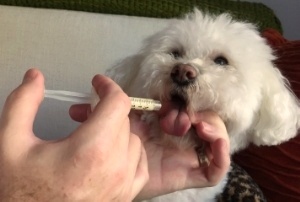
In case your only option is to give the medication as a liquid (sometimes called a slurry), there are still some options.
You will start by crushing the pill into a powder as described above and then add some flavored liquid.
Some dogs will readily lap the liquid from the bowl, but others need to have the liquid administered to them via a syringe.
Buy syringes that don't have the needle in them. This syringe is a good choice. Your vet may be able to give you a few to start with.
Teach your dog to happily take liquid from a syringe by practicing first with non-medicated liquids. Fill the syringe with any of the options below or heavily-diluted peanut butter or wet dog food (so it easily dispenses from the syringe).
Squeeze just a bit out at a time, letting your dog get comfortable with licking it up as you dispense it.
Work up towards giving the entire syringe contents faster and smoother each time before adding in medication.
Here's a quick video showing the process of counterconditioning a dog to eat liquid out of syringe:
Be sure not to add too much liquid to the powdered medication so you aren’t having to administer a large volume of fluid.
The easiest way to prevent this is to draw up the liquid you are using in a syringe first, so you know you won’t be adding too much. Add the liquid to the powder and mix until it is completely dissolved.
Liquid options to add to the powdered medication:
- A low-sodium chicken broth that does not contain onion or garlic. Prior to adding the medication, you can slightly warm the broth. This enhances the smell and makes the powder dissolve easier.
This powdered chicken broth is helpful when only wanting to make a small amount. - Tuna water – just drain the liquid from a can of tuna. Be sure to only use tuna kept in spring water.
- Milk – a dairy-free option can be coconut milk. A lactose-free option is goat’s milk.
- Juice from canned cat food – this is often a good cover-up to dissolve smelly medications.
- 100% pure carrot juice
Injectables
There are also some times when injectable medications are an option — either for you to give yourself at home (after being shown how by a veterinarian or veterinary nurse) or that you can bring your pet to your vet’s office periodically to have given.
And who knows, if you ask nicely (and offer to pay them for their time), one of the veterinary technicians at your vet’s office may even go to your house to help you give the injections (or even pills) to your pet.
Compounding
If giving a pill, capsule, or injection isn’t practical or possible, and if there isn’t a suitable liquid form readily available, then perhaps a reputable and licensed compounding pharmacy could help you and your veterinarian by making their necessary medications into a more palatable (yummy) or otherwise easier to administer form.
Not all medications can be compounded, and even those that can can’t always be compounded into all of the different formulations (see list below). But if your pet needs a medication that can be compounded, you might just be in luck!
Some examples of compounded formulations include:
- flavored liquid suspensions
- flavored chews and treats
- transdermal gels (for applying to the skin)
- smaller capsules
A very important note regarding compounding pharmacies: Like with everything else, not all compounding pharmacies are the same. You need to speak with your veterinarian and do your homework to ensure that you’re using a compounding pharmacy that is reputable and licensed.
The compounding pharmacy also needs to be accustomed to making medications for pets. This is very important.
This National News Headline from 2009 about the compounding pharmacy’s error that led to the death of 21 horses proves that errors can happen.
I know I’ve likely just made compounding pharmacies sound like horrible “rolls of the dice,” which they really typically aren't, and their services are very important in helping to make sure that “difficult to medicate” pets can more easily receive the medications they need.
Like me, lots of vets out there have plenty of pets on compounded medications — both in the short term and for longer periods of medicating.
Excellent compounding pharmacies exist; just do your homework. Find a compounding pharmacy in your area or online, and ask questions so you can best assess them and, of course, talk with your veterinarian.
There's likely a compounding pharmacy they use regularly.
Pros and Cons of Using a Pill Pusher or Pill Gun to Medicate Your Dog
Not everyone is a fan of pill guns, but to be completely honest, I love them for medicating pets. While the thought of using a pill gun can seem scary, they are truly beneficial.
You just place the pill on the top between the rubber ‘flaps.’ Then pull back the plunger. Gently open your pet’s mouth and insert the pill gun from the side, angling to the back of the throat (some dogs, you can go from the front of the mouth and just at the ‘hump’ in the tongue. Push the plunger to expel the pill into the mouth.
Be sure they are given water, a treat, and lots of praise after!
PROS: Why do I love pill guns? Well, let me tell you!
- They are easy to use and speed up the pilling process drastically (once you master how to use it – which is quick to do!).
- They make it easier to get the pill over the ‘hump’ of the tongue, which causes a reflex and makes your pet swallow the pill. That means fewer wasted pills or having to repeat the process.
- Their long and slender design allows them to easily fit into any size mouth, which can be a challenge when you use your fingers. You can often even get it into those pets who are clenching their teeth.
- Their rubber tip, which helps make them safer than a sharp fingernail, fits most pills or capsules, and it generally won’t stick to them (unlike your fingers!).
- They prevent you from getting bit since you are not sticking your fingers in your dog's mouth.
- It makes it easier to give meds when they must be given without food or when a pet is nauseous and refuses food.
WARNINGS: While I love a pill gun, there are a couple of things to be aware of.
- You must be careful not to jab or push it aggressively into the back of the throat because this could cause significant trauma.
- Since you are ‘dry’ pilling, you must provide your pet water using a syringe and massage their throat to be sure they have completely swallowed it. If you can’t syringe them water, be sure they drink water from a bowl immediately after.
This is necessary, so the pill doesn’t get stuck in the esophagus. You can add a bit of pet-safe broth to their water to make it more enticing. - Without positive associations, a pet may start to run away or avoid you when you bring out the pill gun. Prevent this by always pairing it with a treat. You can make using a pill gun even easier by practicing just putting an empty pill gun in their mouth (no medication yet) = yummy treat.
Start slow and easy, and build up to the full process. This is similar to teaching a pet to take liquid medications from a syringe, as explained further above.



